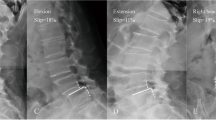Abstract
Purpose
Lumbar flexion–extension radiographs in standing position (SFE) are the most commonly used imaging method to evaluate segmental mobility. Many surgeons use SFE to disclose abnormal vertebral motion and base their decision for surgical fusion on its results. We tested the hypothesis that imaging in standing and recumbent position (SRP) reveals a higher sagittal translation (ST) and sagittal rotation (SR) in symptomatic patients than with SFE.
Materials and methods
We analysed images of 100 symptomatic patients with a low-grade spondylolisthesis that underwent surgical fusion. To determine the ST and SR in SRP, we compared the images taken in the recumbent position in the CT with images taken in the standing position during the routine plain radiography.
Results
The measurement of ST revealed an absolute value of 2.3 ± 1.5 mm in SFE and 4.0 ± 2.0 mm in SRP and differed significantly (p = 0.001). The analysis of the relative value showed an ST of 5.9 ± 3.9% in SFE and 7.8 ± 5.4% in SRP (p = 0.008). The assessment of ST in flexion and in a recumbent position (FRP) revealed the highest ST (4.6 ± 2.5 mm or 9.2 ± 5.7%). Comparison of SR showed the highest rotation in SFE (6.1° ± 3.8°), however, compared to SRP (5.4° ± 3.3°), it missed the level of significance (p = 0.051).
Conclusions
For evaluation of ST in symptomatic patients with spondylolisthesis SRP appears to be more suitable than SFE, while a pathological SR is better revealed in SFE. The analysis of SRP might offer a complementary method to detect or exclude pathological mobility in more cases.


Similar content being viewed by others
References
Pitkanen MT, Manninen HI, Lindgren KA, Sihvonen TA, Airaksinen O, Soimakallio S (2002) Segmental lumbar spine instability at flexion-extension radiography can be predicted by conventional radiography. Clin Radiol 57(7):632–639
Guyer RD, McAfee PC, Banco RJ, Bitan FD, Cappuccino A, Geisler FH, Hochschuler SH, Holt RT, Jenis LG, Majd ME, Regan JJ, Tromanhauser SG, Wong DC, Blumenthal SL (2009) Prospective, randomized, multicenter food and drug administration investigational device exemption study of lumbar total disc replacement with the CHARITE artificial disc versus lumbar fusion: five-year follow-up. Spine J 9(5):374–386
Dupuis PR, Yong-Hing K, Cassidy JD, Kirkaldy-Willis WH (1985) Radiologic diagnosis of degenerative lumbar spinal instability. Spine 10(3):262–276 (Phila Pa 1976)
Kirkaldy-Willis WH, Farfan HF (1982) Instability of the lumbar spine. Clin Orthop Relat Res 165:110–123
Morgan FP, King T (1957) Primary instability of lumbar vertebrae as a common cause of low back pain. J Bone Joint Surg Br 39(1):6–22
Kanemura A, Doita M, Kasahara K, Sumi M, Kurosaka M, Iguchi T (2009) The influence of sagittal instability factors on clinical lumbar spinal symptoms. J Spinal Disord Tech 22(7):479–485
Posner I, White AA, Edwards WT, Hayes WC (1982) A biomechanical analysis of the clinical stability of the lumbar and lumbosacral spine. Spine 7(4):374–389 (Phila Pa 1976)
Shaffer WO, Spratt KF, Weinstein J, Lehmann TR, Goel V (1990) Volvo Award in clinical sciences. The consistency and accuracy of roentgenograms for measuring sagittal translation in the lumbar vertebral motion segment. An experimental model. Spine (Phila Pa 1976) 15(8):741–750
Wood KB, Popp CA, Transfeldt EE, Geissele AE (1994) Radiographic evaluation of instability in spondylolisthesis. Spine 19(15):1697–1703 (Phila Pa 1976)
Luk KD, Chow DH, Holmes A (2003) Vertical instability in spondylolisthesis: a traction radiographic assessment technique and the principle of management. Spine 28(8):819–827 (Phila Pa 1976)
Lowe RW, Hayes TD, Kaye J, Bagg RJ, Luekens CA (1976) Standing roentgenograms in spondylolisthesis. Clin Orthop Relat Res 117:80–84
Penning L, Blickman JR (1980) Instability in lumbar spondylolisthesis: a radiologic study of several concepts. Am J Roentgenol 134(2):293–301
Thome C, Zevgaridis D, Leheta O, Bazner H, Pockler-Schoniger C, Wohrle J, Schmiedek P (2005) Outcome after less-invasive decompression of lumbar spinal stenosis: a randomized comparison of unilateral laminotomy, bilateral laminotomy, and laminectomy. J Neurosurg Spine 3(2):129–141
Epstein NE (1998) Decompression in the surgical management of degenerative spondylolisthesis: advantages of a conservative approach in 290 patients. J Spinal Disord 11(2):116–122 Discussion 23
Leone A, Guglielmi G, Cassar-Pullicino VN, Bonomo L (2007) Lumbar intervertebral instability: a review. Radiology 245(1):62–77
Leone A, Cassar-Pullicino VN, Guglielmi G, Bonomo L (2009) Degenerative lumbar intervertebral instability: what is it and how does imaging contribute? Skeletal Radiol 38(6):529–533
Nachemson AL, Schultz AB, Berkson MH (1979) Mechanical properties of human lumbar spine motion segments. Influence of age, sex, disc level, and degeneration. Spine 4(1):1–8 (Phila Pa 1976)
Friberg O (1987) Lumbar instability: a dynamic approach by traction-compression radiography. Spine 12(2):119–129 (Phila Pa 1976)
Hayes MA, Howard TC, Gruel CR, Kopta JA (1989) Roentgenographic evaluation of lumbar spine flexion extension in asymptomatic individuals. Spine 14(3):327–331 (Phila Pa 1976)
Pennal GF, Conn GS, McDonald G, Dale G, Garside H (1972) Motion studies of the lumbar spine: a preliminary report. J Bone Joint Surg Br 54(3):442–452
Wiltse LL, Hutchinson RH (1964) Surgical treatment of spondylolisthesis. Clin Orthop Relat Res 35:116–135
McGregor AH, McCarthy ID, Hughes SP (1995) Motion characteristics of the lumbar spine in the normal population. Spine 20(22):2421–2428 (Phila Pa 1976)
Pearcy M, Portek I, Shepherd J (1985) The effect of low-back pain on lumbar spinal movements measured by three-dimensional X-ray analysis. Spine 10(2):150–153 (Phila Pa 1976)
Quinnell RC, Stockdale HR (1983) Flexion and extension radiography of the lumbar spine: a comparison with lumbar discography. Clin Radiol 34(4):405–411
Panjabi M, White AA 3rd (1971) A mathematical approach for three-dimensional analysis of the mechanics of the spine. J Biomech 4(3):203–211
Acknowledgment
We thank Mrs. Leah Hecker for editing the manuscript.
Conflict of interest
None.
Author information
Authors and Affiliations
Corresponding author
Rights and permissions
About this article
Cite this article
Cabraja, M., Mohamed, E., Koeppen, D. et al. The analysis of segmental mobility with different lumbar radiographs in symptomatic patients with a spondylolisthesis. Eur Spine J 21, 256–261 (2012). https://doi.org/10.1007/s00586-011-1870-y
Received:
Revised:
Accepted:
Published:
Issue Date:
DOI: https://doi.org/10.1007/s00586-011-1870-y




